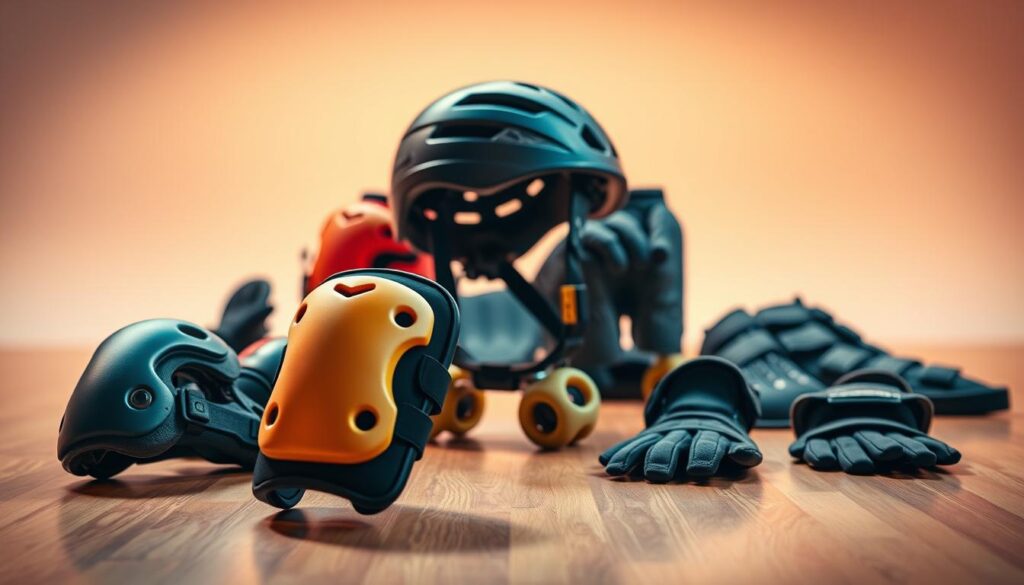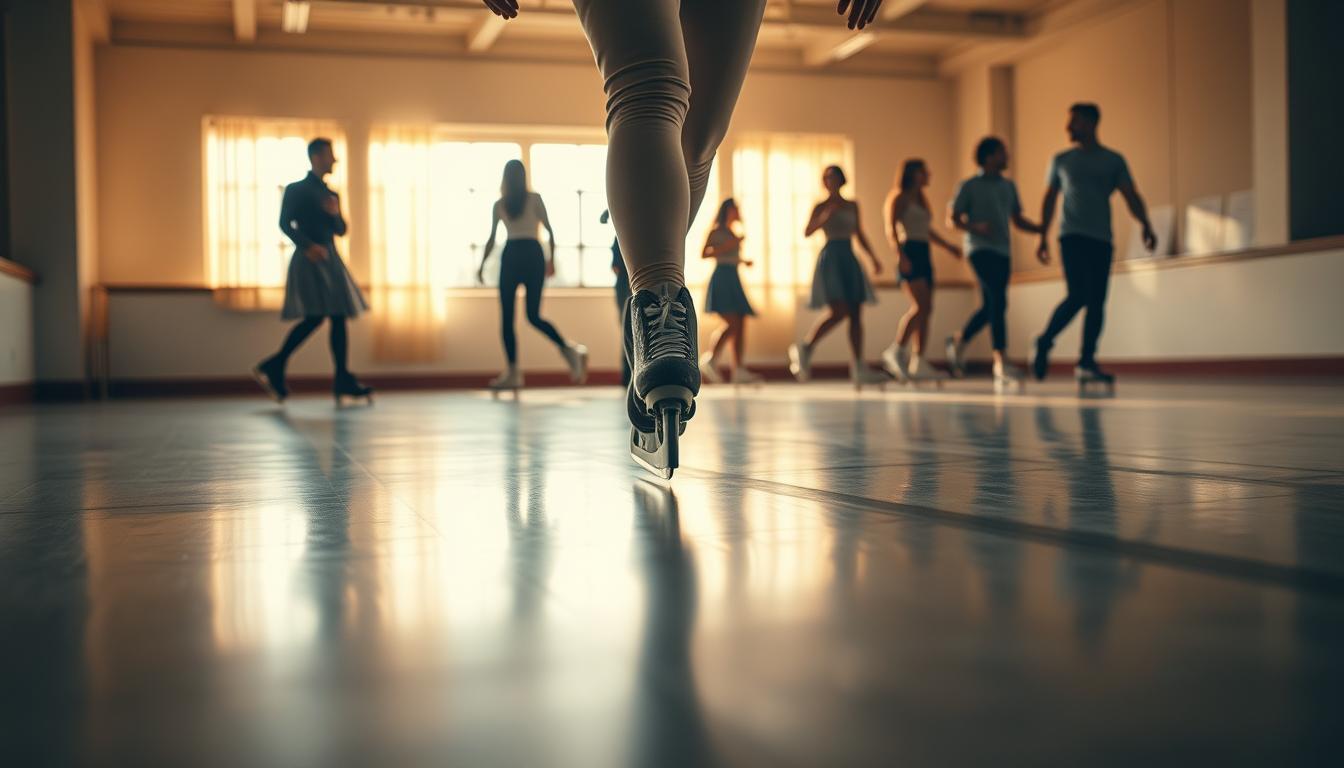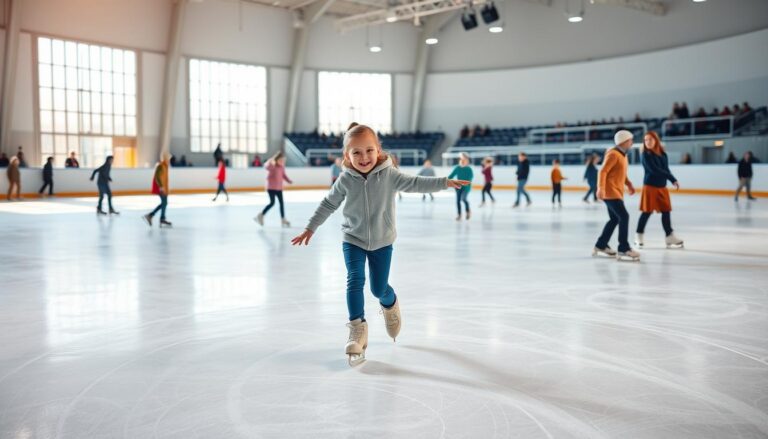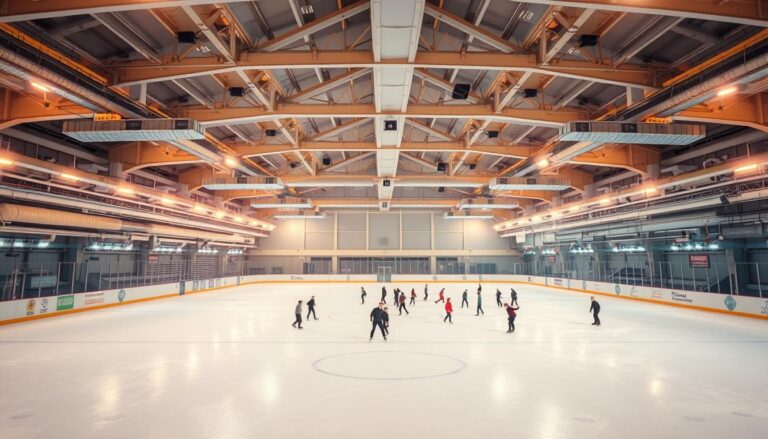Shuffle Skating 101: Everything You Need to Know
Imagine gliding on a smooth surface, your feet moving in a rhythm that’s both dance and motion. Shuffle skating is more than a skill; it’s an experience that turns simple movement into art. It’s loved by many across the United States, from street performances to dance floors.
So, what is shuffle skating? It’s a mix of dance and skating that started in underground dance scenes. It’s like hip-hop dance meets roller skating. Your feet become tools for expression, creating stories with every step.
The history of shuffle skating is rich and diverse. It began in urban dance communities and has grown to become popular everywhere. It’s a way for dancers and skaters to express themselves, making simple movements into powerful art.
Both beginners and experienced skaters are drawn to shuffle skating. It’s a workout that improves coordination, builds strength, and boosts creativity. Whether you want to get fit, learn a new skill, or just have fun, shuffle skating is special.
This guide will be your key to the world of shuffle skating. You’ll learn from basic techniques to advanced moves. It’s a journey where music, movement, and personal expression come together.
Are you ready to start an exciting journey? Your shuffle skating adventure begins here, now. Lace up your skates, feel the rhythm, and let’s explore a world of motion and music!
What is Shuffle Skating
Shuffle skating is a dance-inspired skating style. It turns roller skating into a form of rhythmic movement and personal expression. This style combines dance, music, and precise footwork for a mesmerizing performance.
Shuffle skating is more than just moving forward. It’s about matching your motion to the music’s beat. It started in the 1970s dance scenes and has grown into a sophisticated technique.
Origins and Basic Concepts
The history of shuffle skating began in urban dance communities. Skaters experimented with new footwork. Key features include:
- Rhythmic foot movements for a smooth glide
- Focus on personal style and musical interpretation
- Roots in street dance and roller disco
Difference Between Shuffle Skating and Regular Skating
Traditional skating is about moving forward. Shuffle skating, on the other hand, focuses on:
- Complex footwork patterns
- Dance-inspired movements
- Musical synchronization
Core Movements and Principles
Shuffle skating is all about controlled creativity. Skaters learn unique styles through techniques like the Running Man and T-Step. They aim for a dance-like performance that’s both spontaneous and choreographed.
Whether you’re new or experienced, shuffle skating lets you express yourself through movement, music, and rhythm.
Essential Equipment for Shuffle Skating
Starting your shuffle skating journey means getting the right gear. For beginners, the right equipment can make a big difference. It can turn a smooth glide into a fun experience.
For beginners, focus on the right skates and protective gear. Not all skates are the same. Knowing what to look for is key to success.
Must-Have Shuffle Skating Equipment
- Quad Skates: The foundation of your shuffle skating adventure
- Stable four-wheel configuration
- Ideal for indoor and outdoor surfaces
- Recommended wheel diameter: 58-62mm
- Protective Gear
- Helmet
- Knee pads
- Wrist guards
- Elbow pads
When picking shuffle skates, keep these points in mind:
| Feature | Beginner Recommendation |
|---|---|
| Wheel Hardness | 78A-85A (softer wheels for better grip) |
| Plate Material | Nylon or aluminum for durability |
| Boot Style | Low-cut for maximum ankle flexibility |
Pro tip for beginners: Choose quality equipment that’s comfortable and supportive. Your skates are your dance partners. Pick them wisely, and you’ll glide with confidence!
Getting Started: Basic Stance and Balance
Learning the basic stance is key for shuffle skating beginners. A strong stance helps you glide and move smoothly. This guide will show you how to balance and position yourself for better skating.

Proper Foot Positioning
Foot positioning is a critical skill for beginners. Stand with your feet shoulder-width apart and knees slightly bent. This stance helps you stay stable and ready for action.
- Keep feet parallel
- Distribute weight evenly
- Maintain slight knee bend
- Point toes slightly outward
Body Alignment Tips
Good body alignment is vital for safety and performance. Think of your body as a single, fluid unit. Keep your head up, shoulders relaxed, and core tight.
| Body Part | Correct Position | Common Mistake |
|---|---|---|
| Head | Looking forward | Looking down |
| Shoulders | Relaxed, level | Tense, raised |
| Back | Straight, slight forward lean | Completely rigid |
Weight Distribution Techniques
Smooth movements come from proper weight distribution. Practice moving your weight slowly from one foot to the other. This keeps you balanced and in control.
- Start with equal weight on both feet
- Practice transferring weight slowly
- Use ankle flexibility for smooth transitions
- Keep core muscles engaged
Shuffle skating for beginners is all about patience and practice. Every small step you take will make you more confident and skilled.
Choosing the Right Skates for Shuffling
Finding the perfect pair of skates is key for your shuffle skating journey. The right skates can make your skating experience better. They make shuffle skating tips come to life with every move.
When you start learning how to shuffle skate, your skate choice is very important. Different skates offer special benefits for shuffle skating fans:
- Inline Skates: Great for smooth surface shuffling
- Quad Skates: Better stability for beginners
- Urban Dance Skates: Made for street-style movements
Wheel setup is very important for your shuffle skating. Think about these key points:
- Wheel Hardness: Softer wheels for indoor, harder for outdoor
- Wheel Size: Smaller wheels for control, larger for speed
- Bearing Quality: Good bearings mean smoother moves
Fit is very important when picking shuffle skating skates. Measure your foot well and try on different sizes. A good fit means comfort, no blisters, and better skating.
Pro shuffle skating tips say get customizable skates. Look for ones you can adjust as you get better.
Fundamental Shuffle Skating Moves
Shuffle skating changes your roller experience with cool moves that mix skill and flair. Learning the basics of shuffle skating opens up a world of creativity. These key moves will boost your confidence and let you show off on the rink.
Starting with shuffle skating means learning key moves that are the base of this fun sport. Let’s look at the essential techniques that will improve your skating.
The Running Man
The Running Man is a key shuffle skate move that looks like running while moving. It involves:
- Keeping your knees slightly bent
- Alternating feet in a smooth, rhythmic motion
- Maintaining a low center of gravity
Pro tip: Start with the Running Man slowly, focusing on smooth weight transfer between your feet.
T-Step Basics
T-Step is a flexible shuffle skating technique that makes your moves more interesting. It includes:
- Positioning one foot perpendicular to your direction
- Sliding smoothly while maintaining balance
- Creating complex pattern changes
Heel Toe Movements
Heel toe movements add elegance to your shuffle skating. They involve precise weight shifts and detailed foot placements. These create beautiful patterns on the skating surface.
Begin by practicing these basic shuffle skate moves in a safe place. As you get better, increase your speed and confidence.
Safety Measures and Protective Gear
Shuffle skating for beginners is all about safety. It’s key to protect yourself to get better at this fun sport. Knowing the right safety gear can help avoid injuries and make you feel more confident.

Every shuffle skating fan needs a good safety kit. The right gear can prevent big injuries.
- Helmet: Your most critical piece of safety gear
- Protect against head injuries
- Choose a properly fitted skateboarding or multi-sport helmet
- Replace after any significant impact
- Protective Padding
- Knee pads
- Elbow pads
- Wrist guards
Beginners should always focus on safety. Skaters say good, fitted safety gear is key. It should let you move freely but protect you well.
| Protective Gear | Purpose | Recommended Quality |
|---|---|---|
| Helmet | Head protection | ASTM/CPSC certified |
| Knee Pads | Joint protection | Hard shell with soft interior |
| Wrist Guards | Prevent wrist fractures | Rigid splint design |
Safety is more than just gear. It’s about how you skate. Learn to fall right, skate in safe places, and stay alert. Your safety gear is your ally on the rink.
Common Mistakes to Avoid for Beginners
Shuffle skating for beginners can be tough, but knowing common mistakes helps you improve faster. Everyone starts somewhere. Recognizing errors is key to getting better and looking good.
Learning shuffle skating tips is more than just mastering moves. It’s also about avoiding mistakes that slow you down. Let’s look at the most common challenges beginners face.
Balance Challenges in Shuffle Skating
Keeping your balance right is key for beginners. Many struggle with:
- Leaning too far forward or backward
- Feet being too close together
- Being too tense instead of relaxed
Timing and Rhythm Obstacles
Getting the rhythm right is vital for shuffle skating. Common timing issues include:
- Moving too fast
- Missing the beat
- Making basic steps too hard
Equipment Selection Errors
| Mistake | Impact | Solution |
|---|---|---|
| Wrong skate size | Less control | Get a professional fitting |
| Hardness of wheels not right | Bad grip on the surface | Choose wheels that match the surface |
| Not enough protective gear | Higher risk of injury | Buy quality safety gear |
Pro tip: See mistakes as chances to learn. Every mistake brings you closer to mastering shuffle skating!
Advanced Shuffle Skating Techniques
To improve your shuffle skating, you need to learn advanced techniques. These moves turn simple actions into exciting shows. Skaters create their own styles by mixing complex moves with their own touch.
Advanced shuffle skating is about both skill and creativity. If you want to get better, try these advanced techniques:
- The Grapevine Step: A complex lateral movement requiring exceptional leg coordination
- Crazy Legs: A high-energy technique involving rapid, syncopated foot patterns
- Charleston-inspired Shuffle: Blending vintage dance movements with modern skating
To master these techniques, you need to practice a lot. It’s also important to understand how your body works. Skaters should:
- Build muscle memory through repeating movements
- Keep their weight evenly distributed
- Work on smooth transitions between moves
Each advanced move tests your sense of space and rhythm. Skaters say to break down hard moves into simpler parts. Start small and add more as you get better.
Pro tip: Record your practice sessions. This helps you see what you’re doing right and wrong. It shows how far you’ve come.
Building Your Practice Routine
Mastering shuffle skating needs a smart practice plan. A regular routine helps you get better fast and safely. You’ll build muscle memory, improve your technique, and feel more confident on your skates.

Practicing shuffle skating well means setting aside time for focused practice. The right routine can take you from beginner to expert.
Warm-up Exercises
Getting your body ready is key before skating. A good warm-up prevents injuries and boosts your performance.
- Dynamic leg stretches
- Ankle mobility exercises
- Light cardio to increase heart rate
- Balance and core activation drills
Progressive Training Plans
Make a plan to get better at shuffle skating. Start with the basics and then add more complex moves.
- Week 1-2: Basic stance and balance
- Week 3-4: Simple shuffle movements
- Week 5-6: Advanced footwork patterns
- Week 7-8: Rhythm and style integration
Cool-down Stretches
Recovery is just as important as practice. Use these stretches to ease muscle soreness and boost flexibility:
- Hamstring stretches
- Quadriceps releases
- Calf muscle elongation
- Lower back gentle twists
Consistency is vital in your shuffle skating journey. Go for short, focused practice sessions. They’ll help you build skills and confidence gradually.
Best Locations for Shuffle Skating
Finding the right place is essential for a great shuffle skating experience. The environment you skate in affects your skills and fun. Whether you’re new or experienced, the right spot is vital for mastering shuffle skating.
Different surfaces present unique challenges for shuffle skating. Here are the top spots to improve your skills:
- Indoor Rinks: Controlled environments with smooth surfaces
- Outdoor Parks: Spacious areas with varied terrain
- Dedicated Skate Spots: Purpose-built skating areas
When picking your ideal spot, consider these key factors:
| Location Type | Pros | Cons |
|---|---|---|
| Indoor Rinks | Smooth surface, climate-controlled | Potential rental fees |
| Outdoor Parks | Free, wide-open spaces | Uneven surfaces, weather dependent |
| Dedicated Skate Areas | Designed for skating, community vibe | Limited availability |
For top shuffle skating tips, check out local skating communities. Cities like Los Angeles, San Francisco, and New York have great spots for skaters. Look for smooth concrete paths, basketball courts, or skating zones for plenty of practice space.
Safety is key when choosing your spot. Make sure it’s well-lit, has few obstacles, and supports smooth gliding. Your ideal location will boost your confidence and help you get better at shuffle skating.
Music and Rhythm in Shuffle Skating
Shuffle skating becomes an art when music is added. The rhythm guides your movements, turning each step into a dance. Learning how music and skating techniques work together can make your moves amazing.
Choosing the Right BPM
Beats per minute (BPM) are key in shuffle skating. Most skaters prefer 100-130 BPM for smooth moves. The right music speed depends on your skill and comfort.
- Beginner skaters: 100-110 BPM
- Intermediate skaters: 110-120 BPM
- Advanced skaters: 120-130 BPM
Musical Genres for Shuffling
Various music genres inspire different skating styles. EDM, house, and techno are favorites for their steady beats and lively rhythms.
| Genre | BPM Range | Skating Style |
|---|---|---|
| House | 118-135 | Smooth, flowing movements |
| Techno | 120-140 | Sharp, precise steps |
| Electro | 128-132 | Dynamic, high-energy transitions |
Rhythm Training Tips
Improving rhythm takes practice and focus. Begin by listening to music and trying to find the beat. Internal metronome development is essential for mastering skating techniques.
- Practice counting beats while stationary
- Use headphones during initial training
- Record and analyze your movement patterns
- Attend group rhythm workshops
Your connection with music turns shuffle skating into an art. Embrace the rhythm and let your skates tell a story.
Connecting with the Shuffle Skating Community
Shuffle skating is more than just a sport; it’s a lively community filled with passion and shared moments. Whether you’re new or have been skating for a while, finding your group can change your experience.

Finding the right group can really help your shuffle skating. Here are some ways to meet other skaters:
- Social Media Platforms
- Local Skating Groups
- Online Forums
- Regional Skating Events
Social media has changed how we connect. Sites like Instagram and Facebook have shuffle skating groups. Here, people share tips, techniques, and plan meetups.
| Platform | Community Focus | Engagement Level |
|---|---|---|
| Visual Tutorials | High | |
| Facebook Groups | Local Meetups | Medium |
| Technical Discussions | High |
Local events are great for learning from experts. Many cities now host regular shuffle skating meetups. Here, beginners get hands-on advice and gain confidence.
Competitions aren’t just for pros. Joining local events can improve your skills, boost your confidence, and connect you with others who love skating.
Maintaining Your Shuffle Skates
Keeping your skates in top shape is key for every shuffle skater. Your skates are more than just gear; they’re your dance partners. Learning to care for them is the first step to mastering shuffle skating.
Effective shuffle skating starts with a good maintenance routine. This routine protects your investment and keeps your skates performing at their best. Here are the essential care tips for your skates.
Cleaning Procedures
Cleaning your skates is vital for their performance. Follow these tips for effective cleaning:
- Wipe down your skates after each use with a soft, dry cloth
- Remove dirt and debris from wheels and bearings
- Use specialized skate cleaning solutions for deep cleaning
- Dry completely before storing to prevent rust and degradation
Wheel Rotation Schedule
Regular wheel rotation is essential for even wear and longer skate life. Here’s a recommended schedule:
- Rotate wheels every 20-30 hours of skating
- Check for uneven wear patterns
- Swap wheels between inside and outside positions
- Replace wheels that show significant wear
Bearing Maintenance
Bearings are the heart of your skates. Proper care ensures smooth, effortless gliding. Here are critical maintenance steps:
- Clean bearings every 2-3 months
- Use bearing-specific lubricant
- Remove and inspect for damage regularly
- Replace worn or damaged bearings immediately
By following these tips, you’ll keep your skates in top condition. This ensures maximum performance and longevity. Remember, well-maintained skates are the key to great shuffle skating!
Taking Your Skills to the Next Level
To get better at shuffle skating, you need to be dedicated, creative, and strategic. Professional skaters know that it’s not just about moving your feet. It’s about learning and growing every day.
- Cross-train with other dance styles
- Work on your core strength and flexibility
- Make your own dance routines
- Practice being spontaneous
- Set goals for your skills
Shuffle skating is more than just fun. It can lead to real career opportunities for those who are serious.
| Skill Level | Focus Areas | Potential Outcomes |
|---|---|---|
| Intermediate | Advanced footwork | Performance readiness |
| Advanced | Complex choreography | Professional dance opportunities |
| Expert | Teaching and coaching | Career development |
Remember, every shuffle skating expert started exactly where you are now – committed to continuous improvement and passionate about their craft.
Adding strength training, flexibility exercises, and regular practice will change your shuffle skating. Face challenges, be patient with your progress, and celebrate each achievement on your journey.
Conclusion
Shuffle skating is a thrilling mix of dance, fitness, and self-expression. It’s not just about moving on wheels. It’s a dynamic art form that combines rhythm, movement, and creativity.
This activity offers more than just fun. It’s a full-body workout that boosts your heart health, coordination, and confidence.
Starting with basic skills, every shuffle skater builds their own style. Whether you skate at a rink or in your neighborhood, the journey is personal and rewarding. You’ll learn techniques that improve your balance and unlock musical movement.
Your shuffle skating journey is just starting. Embrace the learning, connect with others, and remember, every expert began as a beginner. Practice often, stay curious, and enjoy the rhythm of your skates.
Ready to start your shuffle skating adventure? Your first step is now. Grab those skates and let your passion lead the way!






